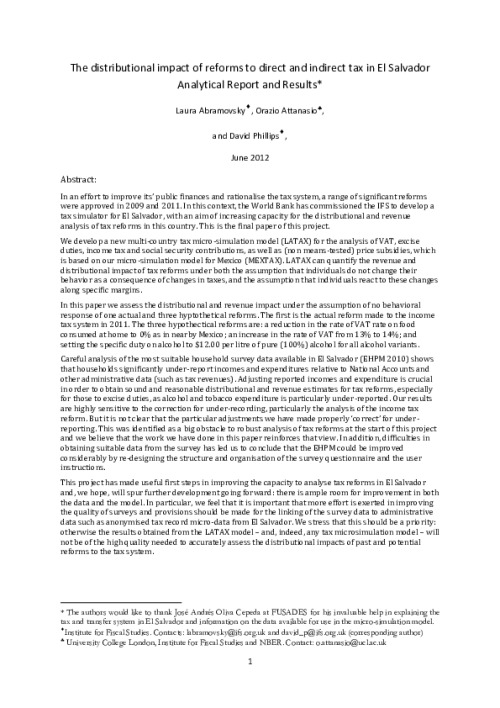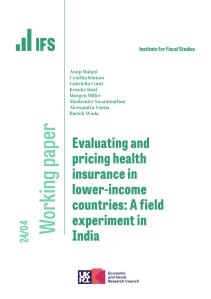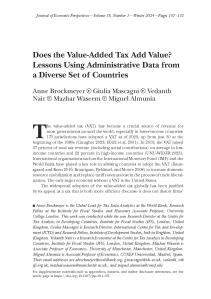In an effort to improve its’ public finances and rationalise the tax system, a range of significant reforms were approved in 2009 and 2011. In this context, the World Bank has commissioned the IFS to develop a tax simulator for El Salvador, with an aim of increasing capacity for the distributional and revenue analysis of tax reforms in this country. This is the final paper of this project.
We develop a new multi-country tax micro-simulation model (LATAX) for the analysis of VAT, excise duties, income tax and social security contributions, as well as (non means-tested) price subsidies, which is based on our micro-simulation model for Mexico (MEXTAX). LATAX can quantify the revenue and distributional impact of tax reforms under both the assumption that individuals do not change their behavior as a consequence of changes in taxes, and the assumption that individuals react to these changes along specific margins.
In this paper we assess the distributional and revenue impact under the assumption of no behavioral response of one actual and three hyptothetical reforms. The first is the actual reform made to the income tax system in 2011. The three hypothectical reforms are: a reduction in the rate of VAT rate on food consumed at home to 0% as in nearby Mexico; an increase in the rate of VAT from 13% to 14%; and setting the specific duty on alcohol to $12.00 per litre of pure (100%) alcohol for all alcohol variants.
Careful analysis of the most suitable household survey data available in El Salvador (EHPM 2010) shows that households significantly under-report incomes and expenditures relative to National Accounts and other administrative data (such as tax revenues). Adjusting reported incomes and expenditure is crucial in order to obtain sound and reasonable distributional and revenue estimates for tax reforms, especially for those to excise duties, as alcohol and tobacco expenditure is particularly under-reported. Our results are highly sensitive to the correction for under-recording, particularly the analysis of the income tax reform. But it is not clear that the particular adjustments we have made properly ‘correct’ for under-reporting. This was identified as a big obstacle to robust analysis of tax reforms at the start of this project and we believe that the work we have done in this paper reinforces that view. In addition, difficulties in obtaining suitable data from the survey has led us to conclude that the EHPM could be improved considerably by re-designing the structure and organisation of the survey questionnaire and the user instructions.
This project has made useful first steps in improving the capacity to analyse tax reforms in El Salvador and, we hope, will spur further development going forward: there is ample room for improvement in both the data and the model. In particular, we feel that it is important that more effort is exerted in improving the quality of surveys and provisions should be made for the linking of the survey data to administrative data such as anonymised tax record micro-data from El Salvador. We stress that this should be a priority: otherwise the results obtained from the LATAX model – and, indeed, any tax microsimulation model – will not be of the high quality needed to accurately assess the distributional impacts of past and potential reforms to the tax system.












